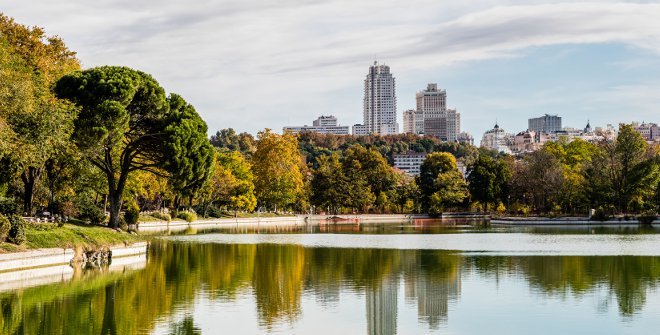
Autumn is a good season to go for an enjoyable walk in the Casa de Campo, it is no longer very hot or dry as in summer. We can get to it in many ways: on foot, cycling, by metro or bus. The metro station Lago on line 10 is one of the better options.
It is a very large garden or historical park covering 1722,6 hectares. It doubles the size of the Bois de Boulogne in Paris and almost doubles that of the Monsanto Forest Park in Lisbon. It`s also two and a half times bigger than the Phoenix Park in Dublin, five times bigger than Central Park in New York, 6.5 times bigger than Hyde Park in London and we can go on. There are a lot of paths to stroll along, some are self-guided walks or you may choose to wander around.
It was once property of the Spanish Royal Crown and a royal hunting estate. After the proclamation of the Second Spanish Republic, it was ceded by the State to the city of Madrid on the 1st of May 1931, being open to the public since then. The complex was declared in 2010 a place of cultural interest by the Autonomous Community of Madrid.
The orography of the Casa de Campo consist of a rugged terrain of gentle hills criss-crossed with various valleys from east to west with a difference in level of 110 metres. There a various singular hills, the highest being the 679 metre Garabitas from which it is worth while climbing to take in a view of the breadth and length of the park.
There are numerous valleys though which flows some streams until they empty into the Manzanares river. Most of them are seasonal and originate in the park. Only two of these streams are permanent and have sources outside the park to the west; the Meaques in the south which is the main river and the Antequina in the north.
The natural vegetation of the Casa de Campo is holm with an undergrowth of broom. However, throughout its history the park has experienced constant transformation such as serving as agricultural land in some periods or reforestation with different species in others. Some of these were pine trees and Arizona cypresses and also others such as the Alamo tree, chestnuts, poplars, plane trees, ash trees, oaks and willows. In 2002, the tree inventory listed 686.294 species.
The fauna in the Casa de Campo is also varied and numerous. 133 vertebrate animals have been listed (87 birds, 20 mammals 14 reptiles, 6 amphibians and the same for fishes). Many of these animals are used to the presence of people and will eat food offered to them although this may not be good for them.
The main birds to be found in the park are pigeons (stock-dove and wood pigeon), swallows, magpies, woodpeckers, royal woodpeckers, spotted woodpeckers, black starling, monk parakeet (an invasive species), great tit, blue tit, wren, nightingale, golden oriole, greenfinch, serin, gold finch, linnet, warbler, blackbird etc. Among the migratory birds that stopover in the park there are the: the graylag goose, mosquito warbler, marsh warbler, thrush, white wagtail, black- headed gull and kingfisher. The monk parakeet, originally bought by people as pets, have huge nest in the trees.
When it comes to mammals it is worth pointing out rabbits, hares and squirrels. There are also moles, hedgehogs, shrews, bats (common and rabudo) dormice and common mice. Rabbits were abundant in past centuries and thousands were hunted to stop them from eating all the vegetation as their natural predators, (foxes, badgers, genets, and the Iberian imperial eagle), are not often seen in the park although they may be spotted in the nearby Monte de el Pardo. Also on some occasions, boars may be seen coming from el Pardo and even venture into urban areas.
The main reptiles are: small lizards (Iberian, redhead lizard, long-tailed lizard and ash-coloured lizard), ocellated lizard, tortoise (leproso and florida which were introduced by people), salamanders and snakes (cogulla and bastard that can reach up to two metres). As for amphibians, there are various toads (common, natter jack and spur), the common frog, Spanish painted frog and Spanish ribbed newt.
The fishes that inhabit the lake are the carp (common and its royal variety), the precasol fish, the carpin fish, the tenta fish, the barbo fish, catfish and the gambusia.
As for insects, the main ones are grasshoppers and beetles.
These are some of the natural wonders that you can find and photograph on your walk. At some other time, I will tell you about the monuments and historical remains that you may come across on your walk.

